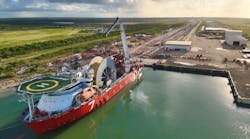John Bradbury
Special Correspondent
This should be a landmark year for the subsea cluster around Bergen on Norway’s coast. The local industry association NCE Subsea is seeking to forge new links with Brazil, one of the most promising markets for the Bergen area’s thriving technology and services sectors.
After signing a formal business cooperation with Espirito Santos state last November, NCS Subsea is determined to help its member companies come to terms with the Brazilian market and the energy opportunities it presents. The accord – which has the aim of establishing a Norwegian business and innovation center in the Brazilian regional capital of Vitoria – came about via the intervention of INTSOK, the Norwegian agency which helps internationalize Norway’s oil and gas expertise.
Following the signing ceremony at the Palace of Anchieta, the state government building in Vitoria, Trond Olsen, General Manager of NCE Subsea, explained what the agreement could mean for the future. “There is a long-term relationship between us and the Espirito Santos region.” Forming links with Brazil, he added, could be used to form the basis of a relationship through which Norwegian companies could support the energy market in Brazil.
Collaborative aims
Along with Australia, Brazil is set to become a significant subsea market for the Bergen region. “We intend through the relationship to make it possible for companies, schools, and research and development institutions to take part in the Brazilian oil and gas industry,” Olsen says.
The deal has five broad aims: collaboration on promoting technological cooperation between small and medium enterprises; coordination of funding mechanisms to encourage partnerships between Brazilian and Norwegian companies; promotion of competitiveness between SMEs; collaboration on national innovation systems; and fostering of oil and gas relations between the two regions through business and research and development with particular emphasis on the subsea sector.
For NCE Subsea, the relationship will mean concentrating on the competencies the Bergen region can provide, “where we have competences we can supply,” Olsen explained.
For some Norwegian companies, having a local partner in Brazil is critical. Aker Solutions has already formed its own local subsidiary for manufacturing in the Brazil energy market. Ultimately, Olsen sees this new collaboration effort leading to the formation of new companies jointly owned by Norwegian and Brazilian entities.
Will this be a two-way process? Initially at least, Olsen says he expects to see the majority of the expertise being exported from the Bergen area to Brazil.
Drivers for innovation
One of the drivers behind the formation of this new partnership is the maturity of some market sectors in the North Sea. “Both the UK and the Norwegian continental shelf are in decline – not within the aftermarket segment, but overall investment is slowing,” Olsen says. Consequently the group has had to broaden its outlook and Brazil is an obvious target with the growing subsea market opportunities it presents.
Local Brazilian companies will have more than enough work to deliver to the national market there, says Olsen. “And that is a policy that they have engaged in. However, it is damaging to a national industry because if you become too focused on your own, national industry, if you just stress local content, you will most likely see higher prices and lower quality products than if your industry is exposed to international competition: You need to compete in international markets. It is better to be connected to the international market because then you can get feedback on your technology and get exposure to quality and technology invented elsewhere.”
But Brazil’s demands are changing too. From the deepwater production benchmark set by the Roncador field in a water depth of 1,700 m (5,577 ft) back in 1997, Brazil is now moving to greater water depths. Equipment for production from 3,000 m (9,840 ft) is now called for. “That is a brand new technology requirement for installation, operations and monitoring,” Olsen pointed out. “You may need to find other ways of working in ultra-deepwater on subsea wells: Accessibility is not going to be the same at 300 m [984 ft] as at 3,000 m – that is quite another story.”
So the skills of the Bergen subsea cluster will be in demand as Brazil embarks on a whole new era of subsea technology which will demand extreme innovation for operation at extreme depths. This is where Olsen believes his member companies can play a part.
Several NCE Subsea partner companies can offer some of the services and technologies that the future deepwater market will need: they include ClampOn and Roxar, which is now providing sand monitoring; Naxys, providing hydro-acoustic monitoring of subsea installations; Framo Engineering and Roxar supplying multi-phase metering; and Bennex, a specialist in subsea cables and couplings.
Further technologies from Norway – such as seabed seismic monitoring – permanent seismic or 4D (time-lapse) seismic are now available to the offshore market through Norwegian suppliers. Other products from the Bergen cluster include high-quality bend stiffeners for risers, oil-in-water monitors, high temperature resistant electronics for downhole use, subsea control systems, and ROVs with ultra-deepwater capability. “The list is long,” Olsen says. “Therefore we have developed a database where cluster companies and other subsea companies can register their products, services and technologies, displaying them for potential customers and suppliers.” The database can be accessed athttp://index.ncesubsea.no.
Recovery targets
Turning to the tends seen in the industry today, Olsen notes that not just on the Norwegian Continental Shelf but also elsewhere, operators are looking to increase oil recovery (IOR) from existing wells, an area in which he believes NCE companies can also play a part.
“Offshore Norway we are now putting increasing emphasis on IOR – how to get more out of each well,” he said. The target recovery rate for subsea wells – usually much lower than surface completed wells – has now been pushed out to 55% and to 70% for platform wells. NCE Subsea cluster companies like Framo Engineering with its pumps and boosting technology are a very important part of that.”
He draws attention to Framo’s recent contract to provide IOR services to Statoil at the Gullfaks field in the North Sea through developing subsea compression, and Aker Solutions’ program to supply a gas compressor for the Shell operated Ormen Lange II project. Both have the ultimate aim of maximizing oilfield recovery. “Framo does all of its development here in Bergen,” Olsen points out.
From its origins in 2006 with a core of 36 member companies to today with a trebling of membership to 112, NCE Subsea has been instrumental in bringing new technology forward, mainly at that critical first stage when individuals or companies need to get their first concept off the drawing board and turned into a project that leads to a finished product.
“The value of membership is in being part of a network,” Olsen says. His organization has often played its part in helping fledgling companies find the first finance needed to get a project off the ground. Once a company has started to move forward, other sources of backing area available from the Industry Technology Facilitator (ITF) and the Norwegian Research Council, but NCE Subsea has provided direct assistance in attracting finance and business partners.
Olsen says this is all part of its work, encouraging technology development, product and supply co-operation, and globalization alongside its support functions of providing recruitment and competence expertise, in addition to public relations and cluster management.
Organizing workshops and seminars are another side to the group’s work, i.e. introducing companies to new markets in the international arena – such as the UK, Brazil, the Gulf of Mexico, and Australia and to a lesser extent northern Russia, where all eyes remain on the Shtokman development. “Things there are taking a long time and there have been several delays in decision points and INTSOK experts think they will start doing something at the earliest by 2020,” Olsen suggested.
Looking at the manpower market in the region, the group is also working to ensure a supply of expertise for the future, by establishing a bachelors’ and a masters’ degree in subsea technology at Bergen University College. Training courses to have been devised and NCE Subsea was instrumental in the formation of the Norwegian Branch of the Society of Underwater Technology.
“We have a lot of expertise in the region,” said Olsen. “But in the years to come we will have to re-focus and help to make more experts available – otherwise I think we will be back to where we were in 2006 to 2008, where demand [for expertise] was higher than the companies here could deliver.”
Getting the energy message across in schools is part of that strategy – even at nursery level: “We have to become more attractive to the kids,” Olsen believes. To that end children have been given access to an ROV-operating simulator which allows them to pilot a vehicle down to a depth of 850 m (2,789 ft) at the Ormen Lange field, and watch it in 3D. NCE Subsea has assisted design of electronic learning packages for 15 and 16 year olds, along with mathematics teaching programs, and the use of subsea concepts at primary school level to combine theory with practice. This is the kind of hands-on experience which Olsen believes is so important in energizing the next generation of oil and gas personnel.
Another educational move is NCE Subsea’s involvement in the world’s oldest subsea conference, the Underwater Technology Conference, which will be taking place at the Greighalen in Bergen on June 8 and 9. For the first time it will include a session providing the subsea chief engineers from some major operators to present and discuss their major challenges. This will provide these senior industry personnel with a platform from which to issue their future technology challenges to the contractors in the regional community.
The conference should also feature a presentation by Norway’s Petroleum Safety Authority on its findings in response to theDeepwater Horizon investigation and the subsequent Macondo well oil spill, and the implications of those events for the Norwegian continental shelf.
Offshore Articles Archives
View Oil and Gas Articles on PennEnergy.com








